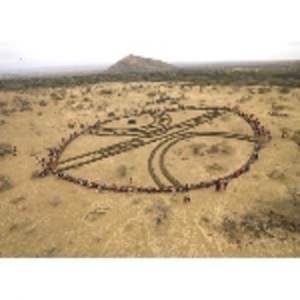Geoglyphs are outsized drawings, incised directly into, or built out of, the earth itself. The most famous of these are probably the Nazca Lines in Peru, if you’re from the New World, and the Uffington White Horse of England if you’re of an Old World bent. Deforestation in the Amazon, along with widely-available mapping imagery, like Google Earth, has uncovered more of these drawings.

But now the contemporary artist Andrew Rogers has turned his hand to the creation of a new set of modern geoglyphs. According to the Google Earth Blog, Rodgers has spent 13 years creating 47 new geoglyphs on seven continents with the assistance of 6,700 volunteers for a project he calls “Rhythms of Life.”
You can download the Google Earth tour Rogers has created in order to view his work, or you can watch the video below.
Artists have always been the willing prey of the Weird Idea, so I don’t think you could call Google Earth a prerequisite for this undertaking. Rogers’ fevered brainpan gave birth to Rhythms of Life, not technology. After all, we’ve had fly-over photographs of geoglyphs for 80 years. What the new media provides is a new and much more extensive distribution network. I don’t know that this network will inspire more of this sort of art, though. Regardless of the easier reach, the artist still has to reach the often distant ground that serves as the canvas.
What do you think of Rogers’ art, now that technology allows you to witness it with little or no trouble? How do these contemporary earthworks compare to the ancient ones? Do they revitalize an antique mode of expression with the sharpness and relevance of the here and now? Or do they lack the cultural vocabulary of line and image developed over centuries, or millennia by the original artists? Does the mere ability to easily present them rob the artist of the hierophantic power he may have shared with his predecessors?
Photo from Andrew Rogers

















